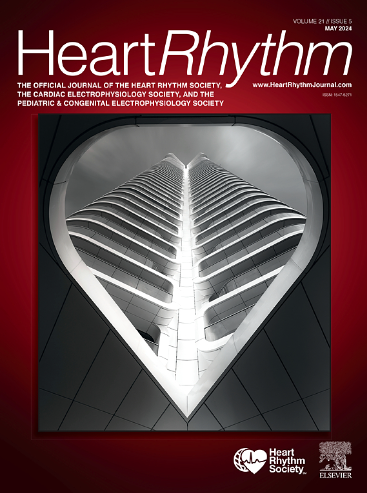根据室性心律失常周期长度确定经皮星状神经节阻滞的疗效:STAR 研究的事后子分析。
IF 5.7
2区 医学
Q1 CARDIAC & CARDIOVASCULAR SYSTEMS
引用次数: 0
摘要
背景:有关经皮星状神经节阻滞术(PSGB)在电风暴(ES)中疗效预测因素的数据很少:目的:评估经皮星状神经节阻滞(PSGB)疗效是否受术前心律失常类型和周期长度的影响:多中心 STAR 研究的子分析。方法:这是一项多中心 STAR 研究的子分析,根据 PSGB 术前最近一次室性心律失常的中位周期长度将人群分为三组:室颤(VF)、快速-VT 和慢速-VT。主要结果是PSGB后一小时内与PSGB前一小时相比,接受治疗的心律失常发作次数(使用ATP和/或DC冲击):我们对 112 名患者的 139 次 PSGB 进行了研究,其中 51 次为 VF,44 次为快速 VT(VT 周期):PSGB是治疗各种类型室性心律失常患者ES的有效方法。然而,PSGB对VF患者的疗效更为显著。本文章由计算机程序翻译,如有差异,请以英文原文为准。
Efficacy of percutaneous stellate ganglion block according to ventricular arrhythmia cycle length: A post hoc subanalysis of the STAR study
Background
Data on the predictors of percutaneous stellate ganglion block (PSGB) efficacy in electrical storm are scanty.
Objective
We aimed to assess whether PSGB efficacy is influenced by the arrhythmia type and cycle length before the procedure.
Methods
This is a subanalysis of the multicenter STAR study. The population was stratified into 3 groups according to the median cycle length of the latest ventricular arrhythmia before PSGB: ventricular fibrillation (VF), fast ventricular tachycardia (VT), and slow VT. The primary outcome was the number of treated arrhythmic episodes (with antitachycardia pacing or direct current shocks) in the hour immediately after PSGB compared with the hour before.
Results
We considered 139 PSGBs from 112 patients divided into VF (51 procedures), fast VT (44 procedures, VT cycle <375 ms), and slow VT (44 procedures, VT cycle ≥375 ms). The number of treated arrhythmic episodes in the hour after every PSGB was significantly lower compared with the hour before in all groups (VF: 0 [0–1] vs 5 [2–8], P < .001; fast VT: 0 [0–0] vs 1 [0–6.5], P < .001; slow VT: 0 [0–0] vs 1 [0–4.5], P = .001). In analyzing the reduction of the number of antitachycardia pacing sequences or direct current shocks from the hour before to the hour after PSGB, a significant trend was observed across the groups (Jonckheere-Terpstra trend P < .001), and a significant difference was observed in comparing slow VT vs VF and fast VT vs VF but not in comparing slow VT vs fast VT. VF was independently associated with the probability of reduction of treated events after PSGB.
Conclusion
PSGB is an effective treatment of electrical storm in patients with all types of ventricular arrhythmias. However, its effectiveness was more pronounced in patients with VF.
求助全文
通过发布文献求助,成功后即可免费获取论文全文。
去求助
来源期刊

Heart rhythm
医学-心血管系统
CiteScore
10.50
自引率
5.50%
发文量
1465
审稿时长
24 days
期刊介绍:
HeartRhythm, the official Journal of the Heart Rhythm Society and the Cardiac Electrophysiology Society, is a unique journal for fundamental discovery and clinical applicability.
HeartRhythm integrates the entire cardiac electrophysiology (EP) community from basic and clinical academic researchers, private practitioners, engineers, allied professionals, industry, and trainees, all of whom are vital and interdependent members of our EP community.
The Heart Rhythm Society is the international leader in science, education, and advocacy for cardiac arrhythmia professionals and patients, and the primary information resource on heart rhythm disorders. Its mission is to improve the care of patients by promoting research, education, and optimal health care policies and standards.
 求助内容:
求助内容: 应助结果提醒方式:
应助结果提醒方式:


